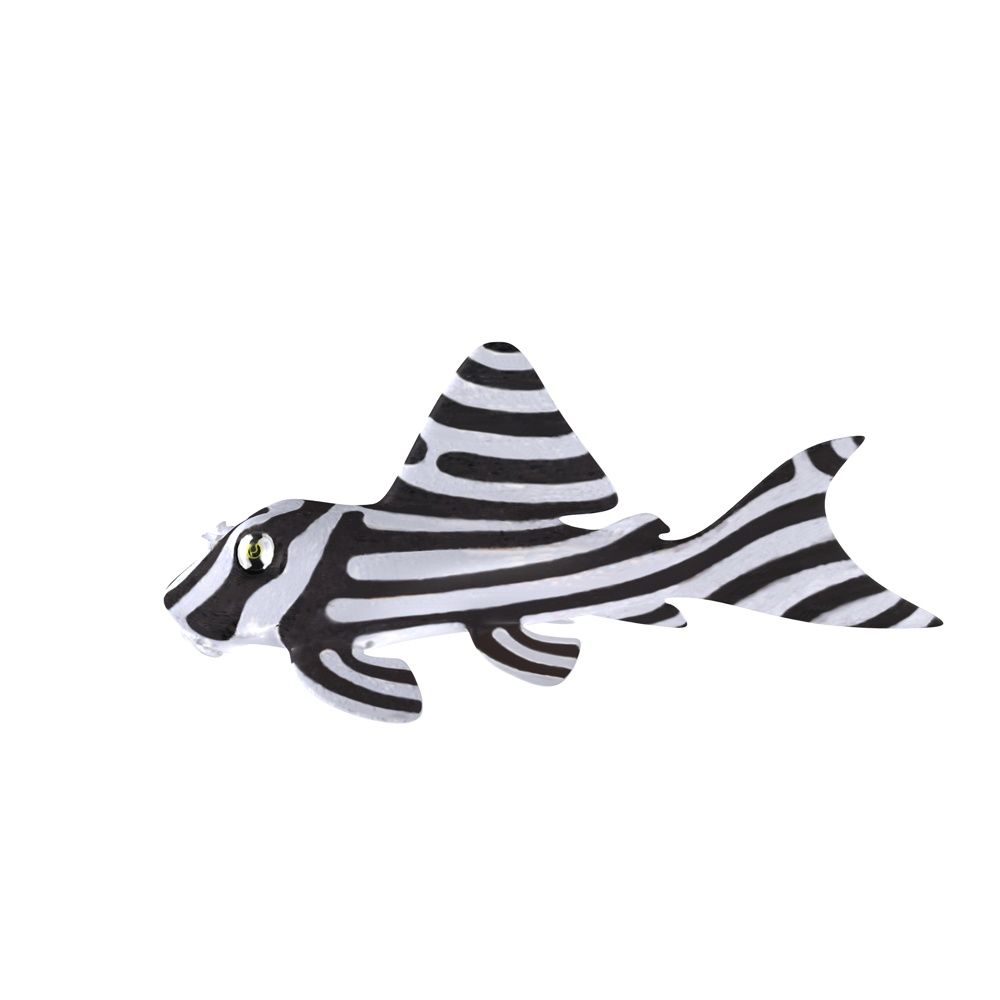The crown jewel of almost all pleco keeper’s collections is none other than the Zebra Pleco. It’s everyone’s top favorite. And you may believe it or not, but there is more of this specie than the most common pleco. You might be already familiar with the blue phantom pleco, clown pleco, and bristlenose pleco. But know that Zebra Pleco is completely different both in appearance and maintenance.
If you are deciding to add L46 fish to your pleco fish collection, this blog serves as your guide. Let’s dive in!
What is the Zebra Pleco?
Zebra Plecos really live up to their name, with bright, bolder back and white stripes that can catch your attention instantly. They also have high-set black eyes that often give them a cute look. When in optimal health, this fish takes on a light blue sheen that is the strongest around its dorsal fin area and its eyes.
Zebra plecos have long been classified as an endangered species and are extremely rare. When we say rare, it actually takes months to years to officially describe these plecos. Hence, the reason why ichthyologists started classifying them with L-numbers as a way to easily refer to a certain undescribed fish.
Now that you know a few things about Zebra Pleco and why it is such a rare and popular fish, let us dive for more information.
Species Information
- Common Name: L46 Pleco, Imperial Pleco, Zebra Pleco
- Scientific Name: Hypancistrus Zebra
- Family: Loricariidae
- Origin: Big Bend region of the Xingu River, Brazil
- Length: 3 to 4 inches
- Aquarium Size: 20-30 gallons
- Temperament: Peaceful
- Difficulty: Intermediate to Advanced
- Reproduction: Egg-layer
- Lifespan: up to 15 years
Water Parameters
- Temperatures: These plecos live in warm waters ranging from 79 to 88 degrees Fahrenheit. We suggest staying somewhere in the middle so that you do not unintentionally pass the safe limits.
- pH: They prefer water that is as close to neutral as possible, hardly tolerating anything lower than 6.5 or much higher than 7.
- KH: The ideal KH or carbonate hardness for this fish is 2-6
- Hardness: Surprisingly, L46 pleco can survive both in soft and hard waters. However, they are usually bred in soft to reasonably hard waters. You can then imitate such conditions in your tank in order to ease your mind.
Husbandry Info
- Diet and Feeding: While these plecos are known to be omnivorous, they are most fond of a protein-rich diet. Whether the protein may come from live, frozen, or dry food is up to you. However, the fish prefer live food, which is typically more beneficial compared to other types.
Fly larvae, bloodworms, and brine shrimps are the best sources of rich protein.
- Suggested Tankmates: They are nocturnal, and you can often see them swimming around the tank when all others are not around. They are territorial. Hence, it is important to pair them with some passive fish with the same activity level and similar size as them.
You can opt for Ember Tetras, Cardinal, Phantom, Denison Barbs, and Platies since they are the most suitable tank mates for L46. Some bottom-dwellers they can interact well include Celestial Pearl Danios and freshwater snails.
Sexual Dimorphism
The thing is, zebra pleco is not an easy species to distinguish between males and females. In fact, there are many differences that can be so hard to spot unless you are directly staring at and making a comparison between the two.
- Males:The Zebra pleco makes characterized for having broader and bigger heads. They also have thicker and longer hairs around their pectoral fins.
- Females: Have a more rounded shape and lesser hairs on the pectoral fins. Only during breeding when the hairs of the females become more prominent.
Behavior and Temperament
Surprisingly, zebra plecos are introverted fish. They do not really like going outside their caves and socializing with other fish.
- Males: These male zebra plecos are more territorial and can be extremely aggressive with each other. They often fight whenever they are trying to stake a particular area inside the tank.
- Females: They are often shy and non-aggressive. However, they can get quite territorial sometimes.
Know that fights usually happen when more than one zebra pleco male is competing for the same female. Battles often break out and may lead to injuries that can cause some diseases, like fin rot. That is why it is highly advised to keep only one male with many females, most especially if your goal is to own a tank full of these fishes.
Pleco Tank Size and Specification
Given that these plecos grow up to a maximum size of 4 inches, a 20-gallon tank is enough to house them. But as an expert, we suggest housing them in a 30-gallon tank together with other fishes of the same kind and compatible tank mates to live harmoniously.
- Filter Type: L46 Zebra pleco often requires heavy water flow and current to survive. Therefore, when doing the same in captivity, you have to be extra careful about the type of filter you will be using. A powerful canister is a great option since it maintains a steady flow of water and guarantees comfortable living conditions of your fish.
- Substrate:Another thing that is worth mentioning in this blog is the substrate. Since L46 pleco is the bottom feeder in the tank, you need to be mindful of the substrate you put in. Particularly, the sand is the ideal substrate mainly because it is found in the wild. Fine gravel, on the other hand, is also a good option.
Tank Set-Up
Let’s just say you are already equipped with the right canister and substrates. Now is the time to set up your tank. Here are some of the best tips in setting up the tank for your zebra plecos.
- Provide hiding spaces, and it should be your first priority on the list. These plecos spend most of their time hiding and only come out at night.
- You must place and scatter a lot of rocks and driftwood around the fish tank.
- You can consider adding rock and ceramic caves since they are a great addition.
- Never forget to add many plants of all sizes and shapes. Ensure the plants are healthy.
- Ensure the water flow of your tank. It should be strong enough because it can affect the health of your plecos. The fish can actually die in non-moving waters, regardless of the correct water parameters. This is the best time to use the canister filters.
- Add sand and fine gravel substrates to the tank. Just make sure that the sizes are not big enough for the plecos. They may accidentally mistake the substrates for food.
Breeding
In breeding pleco, it is something that is often done during captivity. It is a reasonably straightforward process that you can start with a couple of simple water changes:
- Raise the temperature of the tank water to around 80 degrees Fahrenheit. Next, infuse oxygen in the water using a pump and air stone.
- The female will fill with eggs. At this point, the male will chase her directly to the cave. She will lay about 15 eggs, which the male fertilizes.
- The male watches the cave to protect the eggs. He will stick around once they hatch.
- For the first few days after hatching and the babies survive off the egg sac, you can provide powdered fry food even before transitioning to baby brine shrimp.
- After two to three months, they will look like their parents, only smaller and measuring up close to an inch.
Lifespan
Again, these plecos can live anywhere between 10 to 15 years as we previously cited above. So, if you are a passionate aquarist or you an amateur fishkeeper, you are better off choosing a shorter-lived species. Owning L46 requires you to be dedicated and committed, just like owning a dog or a cat. Know that it takes time, effort, and money to provide Zebra Plecos with the best environment so that they can live as long as they can.
Common Possible Diseases
L46 pleco is at high risk of experiencing all of the common freshwater fish diseases. This often includes fungal infections, ich, and bacterial infections. So, if you are about to own a bunch of L46, make sure to do anti-bacterial treatments consistently. But all of these are completely necessary if you properly take care of them and maintain the tank regularly.
Poor water conditions often cause most diseases. This is one important reason to invest in strong filters. It is also essential to change about 20% of the water every week to keep the water healthy and clean. As you know, preventing diseases is always easier than treating them.
Assuming that you have L46 plecos now and one of them gets a disease. What should you do? You quarantine them and look for suitable treatments. A lot of over-the-counter medicines are available today. Check them out.
Are Zebra Plecos Right for You?
Yes! While it is certainly obvious that keeping zebra plecos requires effort and a lot of patience, it does not mean they are not worth having and keeping in your fish tank. Again, they are rare and can live long enough compared to other fish species. They are absolutely a great addition to your fishkeeping collection.
Once you read and follow everything we cited in this blog post, taking care of these plecos and setting up a tank for them will be easy peasy. We hope this guide will strongly encourage you to get your own L26 plecos.
Want to learn more about Zebra plecos? Contact us today.

